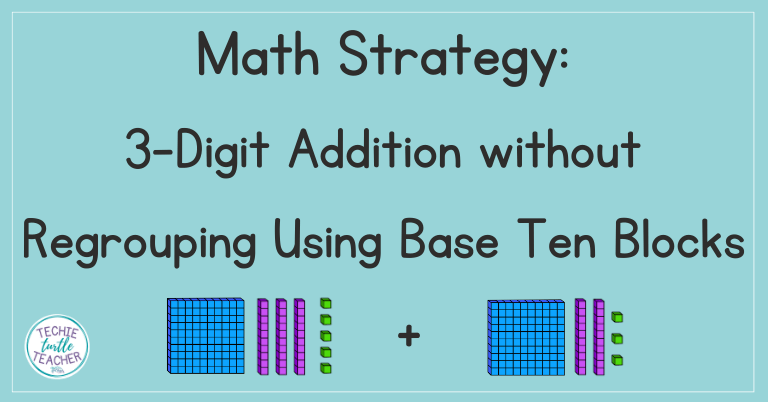Mastering Mental Math with the Using Ten Subtraction Strategy
The using ten subtraction strategy is an effective mental math tool that helps students subtract numbers by using 10 as a benchmark.
Similar to the using ten addition strategy, this method simplifies subtraction by breaking numbers down into manageable parts, reinforcing number sense and improving accuracy in mental math.
The Importance of the Making Ten Addition Strategy
Before students can effectively master the using ten subtraction strategy, they need a strong understanding of the making ten strategy in addition.
The ability to think in terms of numbers that combine to make 10 is foundational for subtraction as well.
Once students are comfortable with making ten in addition, they can apply this knowledge to subtract by 10 in a structured way.
For example:
- In addition, students recognize that 7 and 3 make 10.
- For subtraction, students will learn to use 10 as a benchmark, then subtract step by step.

How the Using Ten Subtraction Strategy Works
In this strategy, students break the number being subtracted into parts that help them reach 10. Once they subtract down to 10, they can easily subtract the rest. This process breaks a complex subtraction problem into smaller, simpler steps.
Let’s look at an example to see how this works.
Example 1: 13 – 8
- Think about how much to subtract from 13 to reach 10.
In this case, subtract 3 from 13 to get to 10. - Break the number you’re subtracting into two parts.
Break 8 into 3 and 5. First, subtract 3 to make 10. - Subtract the rest.
After reaching 10, subtract the remaining 5.
Final answer: 13 – 8 = 5.
By using 10 as an anchor point, students simplify the problem into a manageable series of steps.

Alternative Approach: Breaking the Number Subtracted
Students can also approach the problem by first subtracting to 10, then handling the remaining part in a second step. Let’s break down another example.
Example 2: 15 – 9
- How much do you subtract to reach 10?
From 15, subtract 5 to reach 10. - Break apart the 9.
Split the 9 into 5 and 4. - Subtract in two steps.
Subtract 5 from 15 to get 10, then subtract the remaining 4 from 10.
Final answer: 15 – 9 = 6.
This flexibility gives students two approaches for tackling subtraction problems based on what feels more natural to them.

Why the Using Ten Subtraction Strategy is Important
The using ten subtraction strategy is more than just a trick—it develops students’ number sense by reinforcing their understanding of how numbers can be broken apart and subtracted in steps. With practice, this strategy improves students’ ability to:
- Solve subtraction problems mentally without relying on paper and pencil.
- Develop strong number sense by understanding how numbers relate to one another.
- Gain confidence in solving more complex math problems by breaking them into simpler parts.
Additional Examples
Here are a few more examples to help solidify the concept:
Example 3: 14 – 7
- Think about how much to subtract to reach 10.
Subtract 4 from 14 to get to 10. - Break the 7 into two parts.
Split 7 into 4 + 3. - Subtract the remainder.
After subtracting 4 to reach 10, subtract the remaining 3.
Final answer: 14 – 7 = 7.
Example 4: 12 – 6
- How much do you subtract to reach 10?
Subtract 2 from 12 to reach 10. - Break the 6 into 2 and 4.
Subtract 2 to make 10, and subtract the remaining 4 from 10. - Final Answer:
12 – 6 = 6.
By practicing with similar examples, students will become more comfortable using ten as a benchmark, making mental subtraction faster and more intuitive.
Practice Activities for the Using Ten Subtraction Strategy
- Number Line Subtraction: Use a number line to visually represent how subtraction works by breaking numbers down to 10.
- Ten Frames: Use ten frames to visually subtract to 10 and beyond.
- Ten Frame Poppers: Have students practice with ten frame poppers to give them another visual and a sensory experience to visual the numbers.
- Partner Games: Students can work in pairs, solving subtraction problems out loud using the strategy to help each other understand.
Common Mistakes and How to Avoid Them
Some common mistakes students may encounter include:
- Not breaking the number correctly: Students may need extra support in learning how to break numbers into parts that reach 10 first.
- Skipping steps: Encourage students to think aloud or use visual aids like number lines or counters to keep track of each part of the subtraction.
Providing consistent feedback and practicing with real-world examples will help students gain proficiency in the using ten subtraction strategy.
The using ten subtraction strategy is a key step in building strong mental math skills for students.
By learning to break subtraction problems down into smaller parts and using 10 as a reference point, students develop stronger number sense and increase their confidence in solving subtraction problems mentally.
With consistent practice and the right activities, students will be able to master this essential subtraction strategy, paving the way for success in more complex math challenges.
Get a FREE Using Ten Addition Game
Pin this to Pinterest for later




